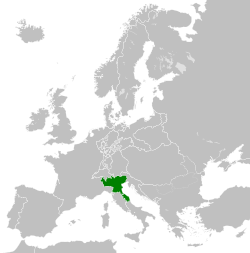Napoleonic Italy
| Kingdom of Italy | ||||||||||||||||||||||
|
Regno d'Italia Royaume d'Italie |
||||||||||||||||||||||
| Client state of the French Empire | ||||||||||||||||||||||
|
||||||||||||||||||||||
|
||||||||||||||||||||||
|
Kingdom of Italy since 1809
|
||||||||||||||||||||||
| Capital |
|
|||||||||||||||||||||
| Languages | Italian, French | |||||||||||||||||||||
| Government | Absolute Monarchy | |||||||||||||||||||||
| King | ||||||||||||||||||||||
| • | 1805–1814 | Napoleon I | ||||||||||||||||||||
| Viceroy | ||||||||||||||||||||||
| • | 1805–1814 | Eugène de Beauharnais | ||||||||||||||||||||
| Legislature | Consultant Senate | |||||||||||||||||||||
| Historical era | Napoleonic Wars | |||||||||||||||||||||
| • | Proclamation | 17 March 1805 | ||||||||||||||||||||
| • | Constitution adopted | 19 March 1805 | ||||||||||||||||||||
| • | Coronation of Napoleon I | 26 May 1805 | ||||||||||||||||||||
| • | Peace of Pressburg | 26 December 1805 | ||||||||||||||||||||
| • | Battle of the Mincio River | 8 February 1814 | ||||||||||||||||||||
| • | Treaty of Fontainebleau | 11 April 1814 | ||||||||||||||||||||
| • | Treaty of Paris | 30 May 1814 | ||||||||||||||||||||
| Currency | Italian Lira | |||||||||||||||||||||
|
||||||||||||||||||||||
The Kingdom of Italy (Italian: Regno d'Italia; French: Royaume d'Italie) was a French client state founded in Northern Italy by Napoleon I, fully influenced by revolutionary France, that ended with his defeat and fall. Formally in personal union with the French Empire, with Napoleon I reigning as its king throughout its existence, direct governance was conducted by Napoleon's step-son, Eugène de Beauharnais, who served as Viceroy for his step-father.
The Kingdom of Italy was born on March 17, 1805, when the Italian Republic, whose president was Napoleon Bonaparte, became the Kingdom of Italy, with the same man (now styled Napoleon I) as King of Italy, and the 24-year-old Eugène de Beauharnais his viceroy. Napoleon I was crowned at the Duomo di Milano, Milan on May 26, with the Iron Crown of Lombardy. His title was "Emperor of the French and King of Italy" (French: Empereur des Français et Roi d'Italie), showing the importance of this Italian Kingdom for him.
Even though the republican Constitution was never formally abolished, a series of Constitutional Statutes completely altered it. The first one was proclaimed two days after the birth of the kingdom, on March 19, when the Consulta declared Napoleon as king and established that his sons would succeed him, even if the French and the Italian crowns had to be separated after the Emperor's death. The second one, dating from March 29, and regulated the regency, the Great Officials of the kingdom, and the oaths.
...
Wikipedia



